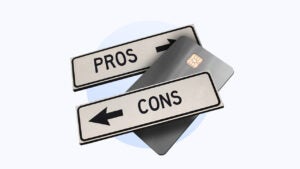Pros and cons of credit card forbearance




Key takeaways
- Credit card forbearance can help you manage your credit card payments, balance or potential interest or fee costs if you’re facing financial hardship.
- You typically have to request credit card forbearance, although not all issuers offer this option. Otherwise, you may have to consider balance transfer cards or other debt management options (if you’re eligible).
- Card forbearance won’t hurt your credit at the outset, but accumulating a large balance from resulting interest could lower your credit score.
Bankrate’s latest credit card debt survey reports that 48 percent of cardholders are now carrying a balance, and 53 percent of cardholders have been carrying this debt for a year — a growing trend due to inflation and high interest rates. If factors like these and an unexpected financial hardship have left you wondering how you’re going to pay your credit card bill each month, your credit card issuer may be able to work out a solution. Some issuers offer credit card hardship assistance — also known as credit card forbearance — to help you continue paying your credit card bill.
Many individuals learn what “credit card forbearance” is when they’re in a pinch and their credit card company offers the option. Forbearance programs let you negotiate with your issuer to temporarily provide relief during financial hardship, whether that’s an adjustment to your monthly payment or reduced interest rates. These assistance programs are in the issuer’s best interest as well since they’d prefer to have the money they’re owed than have your card going into default. However, credit card forbearance can have serious effects on your account and credit score, so it’s important to know whether the helping hand is worth it in your unique situation.
What is credit card forbearance?
Credit card forbearance is a method of debt management offered by credit card issuers to aid cardholders in times of financial strain — like losing a job or other crises that reduce your income. However, it’s generally up to you to ask the issuer for credit card forbearance assistance, so you’ll usually have to explain your hardship and provide evidence that you can repay the issuer once the temporary assistance ends (typically within 12 months). Unfortunately, that also means the issuer can deny your forbearance request if your payment history or credit score show you won’t be able to reliably repay them.
The type of forbearance you may qualify for in a time of fiscal hardship depends on your personal finances and the card issuer’s policy. Credit card forbearance can come in many forms including:
- Credit line extensions
- Paused or lowered minimum payments (for a set period of time)
- Reduced interest rates
- Waived fees (like late payment fees)
It’s important to understand that credit card forbearance is not debt forgiveness, but rather a form of temporary financial relief. Credit card forbearance doesn’t forgive or waive any of your debt, only the fees and interest associated with your debt. For example, if your credit card issuer defers your payment for a predetermined period of time, you will eventually have a payment once that period of forbearance is over. It doesn’t simply go away.
Just keep in mind that the support you get from credit card forbearance can be different with each issuer, and your issuer may not offer this option at all, so carefully consider how much it may help versus the drawbacks.
Learn more: What debt relief option is right for you?
Pros of credit card forbearance
Credit card forbearance may temporarily make your credit card payment more manageable and might save you money on interest or late payment fees. In this way, credit card forbearance could free up your money to go towards more pressing expenses such as an auto loan, mortgage, medical bills and more.
Learn more: How to negotiate debt with credit card companies
Cons of credit card forbearance
Forbearance may seem like an ideal option when facing mounting bills and stress during uncertain financial times, but it’s a bit like putting a Band-Aid on a bullet hole. It may help for a short time, but the wound (or, in this case, the debt) will still be there when you take the bandage off.
Because the forbearance terms and conditions vary by each card issuer, it’s possible you could be worse off after putting your credit card balance in forbearance than you were before.
For example, if your balance is in forbearance in exchange for reducing monthly payments rather than pausing them altogether, you’ll actually be paying more in the end due to added interest.
Similarly, if the issuer increases your credit limit and you continue to use your credit card without the means to pay off your balance at the end of the month, you’ll rack up more debt on top of the balance you weren’t able to pay off the first time around.
How credit card forbearance impacts your credit score
As long as you make on-time payments and you continue to follow the terms of the forbearance program established by your credit card issuer, your credit score will not be negatively impacted.
However, if you end up with a big balance through forbearance assistance factors like accrued interest or smaller minimum payments, your credit score will likely go down because your credit utilization will go up. Granted, the effect a higher credit utilization ratio would have on your credit score is likely easier to manage than the damage a credit card delinquency would have on your credit, so forbearance could still be a more appealing option if your account may go into default otherwise.
How is forbearance different from deferment?
The term forbearance and deferment are often used synonymously, but there are a few key differences you should be aware of. A deferment of payments is not the same as forbearance, and generally a true “deferment” only applies to student loans, rather than credit card balances.
If your credit card issuer allows you to defer payment, in almost all cases the interest during the deferment period will still be compounding. Conversely, if your credit card balance is put into forbearance, fees associated with the balance could be temporarily suspended — though this depends on the issuer and in most cases interest will still accrue.
Bankrate’s take: If you want to not just defer interest but fully keep it at bay while you pay off your balance, and you have a good-to-excellent credit score, you may be able to obtain a balance transfer card and make payments within the 0 percent APR period to avoid the interest costs that would return at the end of the forbearance period.
Another important difference between deferment and forbearance is the duration of the time for which payment collection is halted. In the case of credit card deferment, payment collection is typically suspended for a short period of time (usually one month or less) and repayment in full is expected as soon as the grace period ends. In the case of forbearance, the time period in which relief assistance methods may last is longer — in some cases several months or up to a year.
The bottom line
If you’ve suddenly had trouble making ends meet, credit card forbearance may be able to make it easier to handle your balance, credit card payments, APR and/or card fees. On the flip side, it’s also important to consider the risks associated with longer repayment periods, reduced monthly payments or increased credit limits — especially if you’re struggling with your credit management habits.
Keep in mind, if your credit card issuer extends a longer repayment period to you, you will be paying more interest over time because your debt is being stretched, not minimized. Your principal balance isn’t changing, it’s simply being pulled into smaller pieces month-to-month. You might be able to sidestep credit card forbearance with options like zero-interest credit cards, creating a debt management plan, seeking credit counseling or consulting credit repair companies, but forbearance can be a helpful option if you’re eligible and you stick to an actionable repayment plan.
If you’re experiencing financial struggles, reach out to your credit card issuer to see how they can help you during times of financial hardship.
Dig deeper: Credit card debt resources





